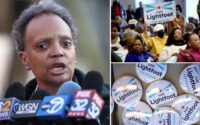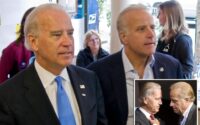COVID scientists downplayed lab leak in fear of China: panel
Scientists who wrote a paper dismissing the so-called “lab leak theory” of the origin of COVID-19 admitted they feared blaming China for accidentally releasing the virus, according to internal communications obtained by a House subcommittee.
A co-author of the March 2020 Nature Medicine article “The Proximal Origin of SARS-CoV-2” and other scientists who collaborated on the paper privately worried about the “s–tshow that would happen” if “China in particular” were deemed responsible for COVID escaping one of their research labs, the House Select Subcommittee on the Coronavirus Pandemic revealed in an interim report Tuesday.
“Given the s–tshow that would happen if anyone serious accused the Chinese of even accidental release, my feeling is we should say that given there is no evidence of a specifically engineered virus, we cannot possibly distinguish between natural evolution and escape so we are content with ascribing it to natural process,” Dr. Andrew Rambaut, a professor of evolutionary biology at the University of Edinburgh, wrote in a Feb. 2, 2020, Slack message to co-authors Dr. Kristian Andersen, Dr. Edward Holmes and Dr. Robert Garry.


“Yup, I totally agree that that’s a very reasonable conclusion,” Andersen responded. “Although I hate when politics is injected into science — but its [sic] impossible not to, especially given the circumstances.”
Another scientist — who had joined the co-authors, then-National Institutes of Health Director Dr. Francis Collins and National Institute of Allergy and Infectious Diseases Director Dr. Anthony Fauci a day earlier on a conference call — also urged his colleagues to tamp down lab leak discussions that might imperil “science in China.”
“An accusation that nCoV-2019 might have been engineered and released into the environment by humans (accidental or intentional) would need to be supported by strong data, beyond reasonable doubt,” Dutch virologist Dr. Ron Fouchier wrote in a Feb. 2, 2020, email. “It is good that this possibility was discussed in detail with a team of experts. However, further debate about such accusations would unnecessarily distract top researchers from their active duties and do unnecessary harm to science in general and science in China in particular.”

The House COVID panel’s report combed through more than 8,000 pages of documents from the scientists and interviewed five of them about the paper that Fauci twice “suggested” and that Andersen said was ultimately written to “disprove” the COVID lab leak theory.
Fauci and Collins involved themselves so much in the effort that co-authors referred to them in email exchanges as the “Bethesda Boys,” the report shows, and Fauci later cited the paper in a televised White House briefing to discredit the lab leak hypothesis.
The House report also shows the article faced initial rejection from Nature Medicine for not sufficiently disproving non-natural origins of COVID-19.

Rambaut, Andersen, Holmes, Garry and Dr. W. Ian Lipkin first published a draft on the website Virological on Feb. 16, 2020. Nature published the final paper on March 17, 2020.
“Proximal Origin” co-authors Andersen and Garry appeared before Chairman Brad Wenstrup (R-Ohio) and other panel members on Tuesday to testify about the paper and COVID origin theories.
In his opening statement, Andersen disputed that Fauci solely prompted the COVID paper, adding that Collins and Dr. Jeremy Farrar supported the work.
“There was no prompting to disprove or dismiss a potential lab leak,” Andersen went on. “In fact, when I outlined my initial hypothesis about a potentially engineered virus, Dr. Fauci told me — and I’m paraphrasing here — if you think this virus came from a lab, you should write a scientific paper about it.”

“My initial hypothesis was a lab theory. When I stated that we were trying to disprove any type of lab theory, I was specifically referring to us testing our early hypothesis. This is textbook science in action,” he said.
That testimony was borne out earlier in the House report, which shared a message where Andersen expressed early concerns about COVID-19 being genetically modified or engineered.
“Eddie, can we talk? I need to be pulled off a ledge here,” Andersen texted Holmes.
In sworn congressional testimony from June 16, Andersen also said he thought at the time that the virus “could be engineered.”
Rep. Nicole Malliotakis (R-NY), a member of the House COVID subcommittee, asked why researchers like Rambaut were concerned about inflaming tensions with China — and why Andersen reversed course from his initial hypothesis within days of Fauci contacting him.
“Something happened here,” she said, referring to the time between when Fauci first contacted Andersen on Jan. 31, 2020, and initial discussions of the paper’s focus. “Politicians may flip-flop. Scientists do not flip-flop in a matter of 72 hours.”
Andersen also denied that a federal grant he received after authoring the paper was a quid pro quo for having completed the scientific study. He said the work was “based on scientific evidence and analyses by a team of international experts with extensive track records in studying infectious disease emergence” and “peer reviewed by independent experts, resulting in multiple revisions.”


